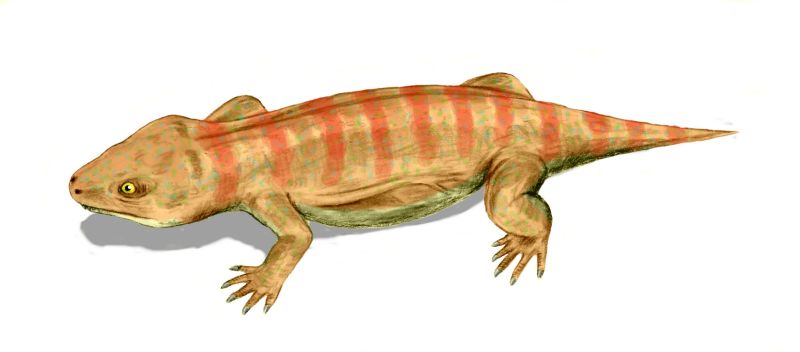- Procolophon
Taxobox
name = "Procolophon"
fossil_range = LatePermian -LateTriassic 
image_width=250px
image_caption = "Procolophon pricei" from the Early Triassic of South Africa
regnum =Animal ia
phylum =Chordata
classis =Sauropsida
ordo =Procolophonomorpha
familia =Procolophonidae
genus = "Procolophon"
subdivision_ranks =Species
subdivision =
*"P. pricei"
*"P. trigoniceps""Procolophon" were a genus of lizard shaped reptiles with at least 8 species that persisted through the
Permian–Triassic extinction event , only to die out in the early stage in the evolution of thedinosaur s.The skull was solid but some species did evolve the fenestrae in the skull independently of other reptile. There was one backward facing cheek spikes, but its function is debated, may have deen for muscle attachment. Eyes were large and may have had acute day or night vision. With the teeth being peg like and sutable for crushing of plant matter. The front of the
skull was short and blunt with the nasal opening very close to the mouth.The
vertebrae was robust with a roundedrib cage composed of many small weakrib s. Legs were short, thickly built with shortphalange s, this suggests an animal who burrowed and did not run fast.References
* [http://www.ufrgs.br/geociencias/paleo/procolophoni.html Skull of P. pricei.]
* [http://gatito.valdosta.edu/fossil_pages/fossils_tri/r6.html Cast of the skull from South Africa.]
* [http://digitallibrary.amnh.org/dspace/handle/2246/5455 The Triassic reptile Procolophon in Antarctica.]
*de icon [http://leute.server.de/frankmuster/P/Procolophon.htm Artistic impression]
* [http://www.erin.utoronto.ca/~w3bio356/lab_info/lab_04/procolophon.htm Upper skull]
* [http://www.collectionscanada.ca/obj/s4/f2/dsk3/ftp05/NQ63812.pdf Scientific evaluation for the genus.]
*D.Lambert, D.Naish and E.Wyse 2001, "Encyclopedia of Dinosaurs and prehistoric life", p. 76, Dorling Kindersley Limited, London. ISBN 0-7513-0955-9
Wikimedia Foundation. 2010.
